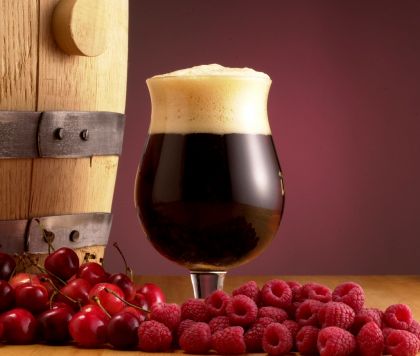Sometimes, one sip of a beer can transport you back through the centuries, a sort of liquid time machine. The sour beer of Flanders, with its unique tangy, fruity aroma, magical ruby color, and refreshing yet earthy taste, can do just that.
Because of their simple malt/hop profile and bright acidity, these beers make great bases for fruit beers.
This archaic beer style will take you to a time when stainless steel was just a twinkle in an alchemist’s eye, back a couple of hundred years, at least, to when wood was the only practical material available for constructing fermentation vessels. What you get with wood fermenters, along with a high load of maintenance obligations, is a zoo of little creatures that snuggle in and use the beer as their own personal picnic grounds. This can be a nightmare if it goes wrong, but such microbial colonies can at times be wholly elegant, adding a profound, earthy perfume to the brew, plus lactic and acetic acids that overlay a quenching tartness

Present commercial versions of the Flanders sour beer style are made with a small proportion—less than 25 percent—of soured beer, blended into a batch fresh from a few weeks’ fermentation. This dilutes the overwhelming sourness of the aged beer and, of course, adds complexity.
Some sources draw a distinction between the East and West Flanders versions of this beer type, the West Flanders variant generally the sharper tasting. But to me, the differences seem less important than the similarities. Once, such beers were plentiful in Flanders; today, only a few remain. In a situation in which the number of producers is greatly reduced, the big picture gets distorted and the idiosyncrasies of brewers that remain get magnified beyond their importance as far as the original style is concerned.
Flanders Specifications
Gravity is modest at 1045 to 1050, although stronger versions are possible. Color should be a rich reddish brown. Hopping is light, as with most types of sour beers, with no detectable hop aroma. The palate should be dry, with a very soft, malty roastiness balanced against the acidity.
Because of their simple malt/hop profile and bright acidity, these beers make great bases for fruit beers, with cherries and raspberries being preferred.
Brewing is straightforward; a simple infusion mash is adequate. Relatively low mash temperatures should be used, as this promotes the kind of enzymatic activity that creates a highly fermentable wort, which in turn creates a crisp, dryish beer. This is a good beer to brew from extract, with augmentation from some crystal malt.
Only one essential detail remains: how to get it to turn sour. I have had good results from the Wyeast mixed lambic culture, added after primary fermentation is complete. These critters are rather slow at the smorgasbord, so expect to wait a few months before you get much effect from them. I would let them have at it for maybe three months, then have a taste.
As mentioned, oak vessels are traditional. And at Rodenbach, at least, the barrels are scraped to expose fresh wood between every brew. In addition to being a good home for acetobacteria, especially, oak ultimately imparts a soft vanilla character, the result of the metamorphosis of lignin in the wood into vanillin.









